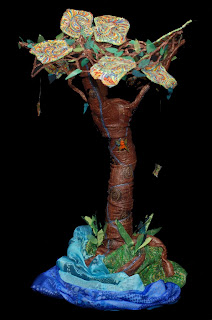 |
| Sisters' Road (2012) - Ramona Dallum Lindsey |
Life is a journey that should not be traveled alone. It is
riddled with peaks and valleys that are best navigated with experience,
knowledge, and wisdom. When two or more
walk together, the impact of experience, knowledge and wisdom improves. Men journey differently through life than
women. Women depend on a strong,
enduring sisterhood to navigate our journey.
We depend on like minded women committed to purposes greater than the
individual. As each woman connects to the sisterhood, she finds the strength to
identify and fulfill her purpose.
Sisters' Road is a triptych consisting of three related panels
- Founders'
Road, Builders' Road, and Legacies' Road. Together these panels tell the story of an
enduring sisterhood.
Each form symbolizes mind, body, and spirit connected by faith, hope, and love. They stand proudly on a crimson road showcasing their courage and strength to be undeterred against challenges in life's journey. When the three panels are placed side by side one can see in the distance the courage of the founders shoulder to shoulder staking the foundation for a lasting sisterhood. The chain continues as sisters work together to build upon the founders' goals and missions. Lastly, the legacy of the sisterhood is dependent on the efforts of current and future members to radiate into the world.
Each form symbolizes mind, body, and spirit connected by faith, hope, and love. They stand proudly on a crimson road showcasing their courage and strength to be undeterred against challenges in life's journey. When the three panels are placed side by side one can see in the distance the courage of the founders shoulder to shoulder staking the foundation for a lasting sisterhood. The chain continues as sisters work together to build upon the founders' goals and missions. Lastly, the legacy of the sisterhood is dependent on the efforts of current and future members to radiate into the world.
Women often find themselves belonging to a
number of sisterhoods. Some were born
into a sisterhood through the union of their parents. Faith made others members
of spiritual sisterhoods. Common
interests encouraged some women to create social sisterhoods. Some sisterhoods encompass
many areas of women's lives. Delta SigmaTheta Sorority, Inc. is such a sisterhood.
It was found January 13, 1913 as a sisterhood of black college educated
women committed to public service. Many
of the sorority's defining principles are rooted in Christian principles. I became a member of Delta Sigma Theta
Sorority, Inc. in 1991. Sisters'
Road is my tribute to Delta Sigma Theta Sorority, Inc. and the many
sisterhoods embodied by its members.
Sisters' Road will be featured at Gallery D'Estee March 2nd & 3rd at the Parkway Ballroom. The triptych will be available for purchase.



